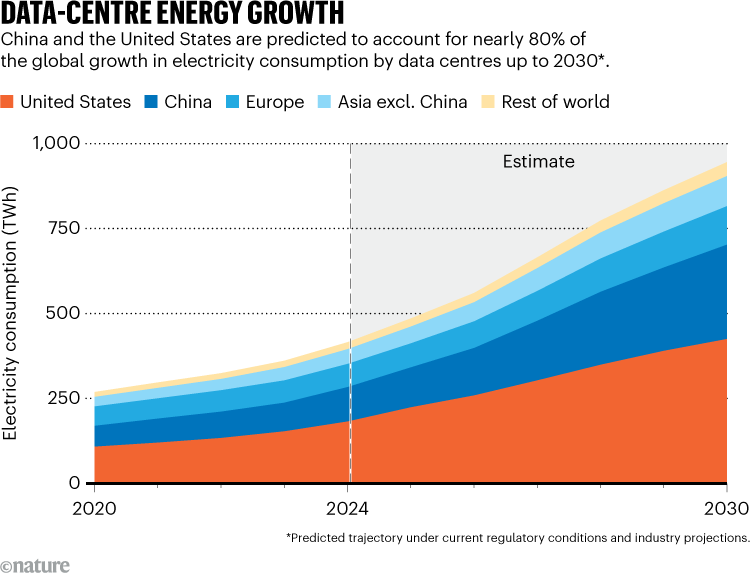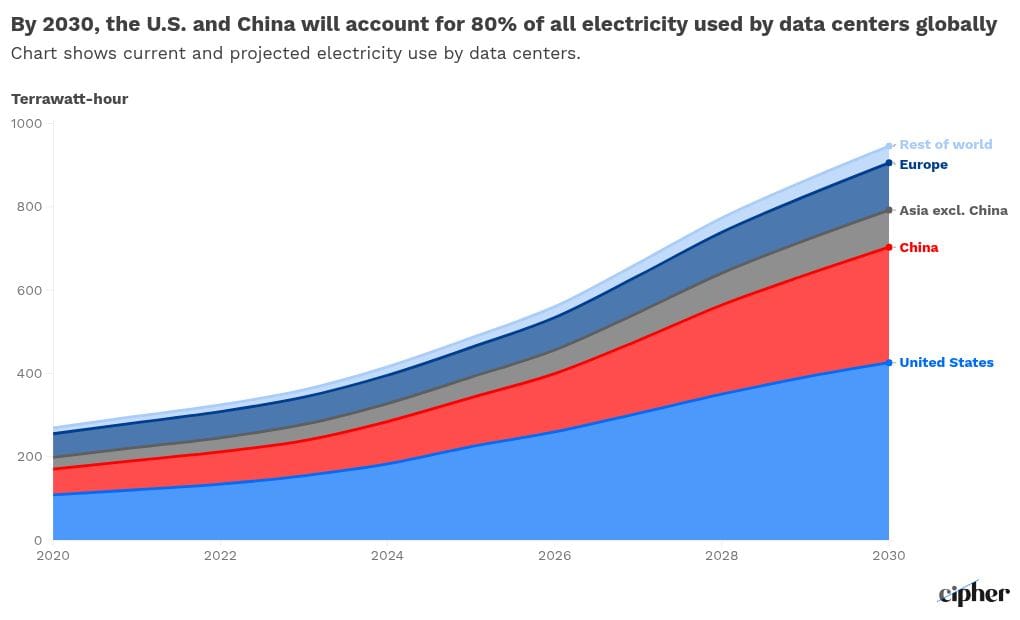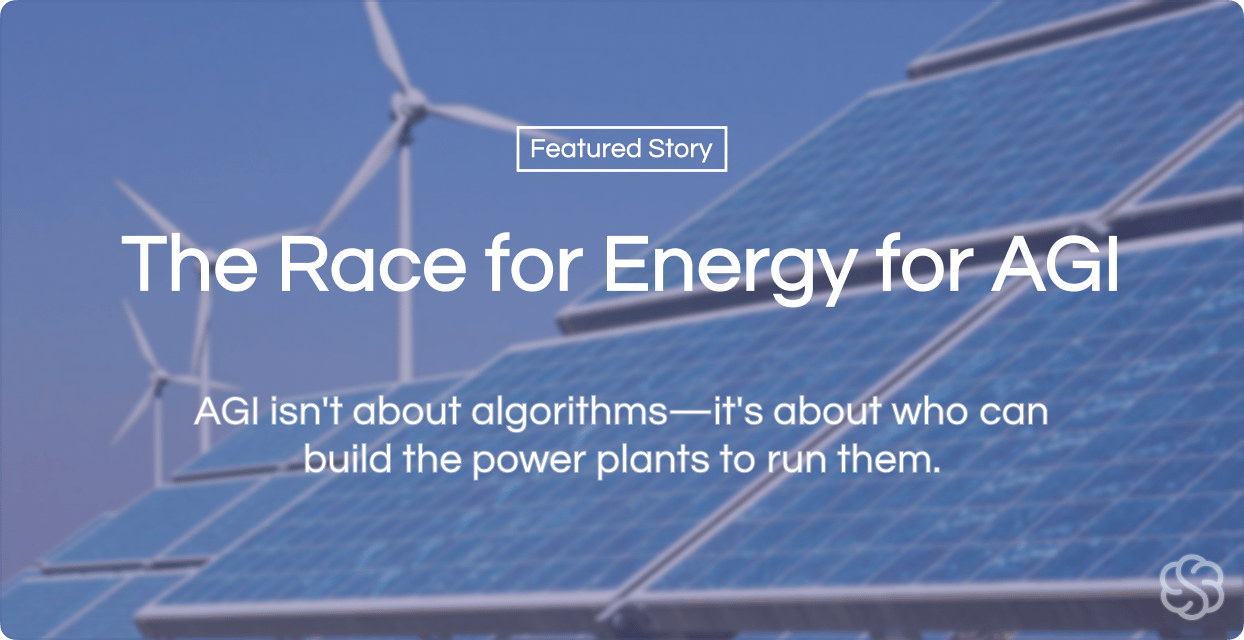
Dear Readers,
The race for artificial intelligence is often portrayed as a competition between algorithms – but in reality, a much more mundane resource will determine victory or defeat: electricity. As models become larger and more powerful, data centers are reaching the limits of their power grids. Anyone who wants to seriously scale AGI will not only have to invest billions in chips, but also ensure that the lights stay on. So the question is: Who will be able to generate enough energy in the coming years to power world-class intelligence? In this issue, we look at the three major blocs: China is building grids in record time but continues to rely on coal; the US has gas and renewable options but is losing time in a jungle of approvals; and Europe shines with clean energy but remains fragmented and slow. We also offer insights into why the kilowatt hour is suddenly becoming a geopolitical power factor—and why the future of AI is more likely to be decided on high-voltage power lines than in research laboratories.
All the best,

The Race for Energy for AGI
The TLDR
The race for AGI is becoming a race for energy, as the massive electricity demand from AI data centers is set to double by 2030, creating a critical new bottleneck for technological progress. This global power crunch is shifting the geopolitical competition between the US, China, and Europe from a battle over algorithms to a high-stakes struggle for control over energy grids and power generation.
How much power does intelligence need when it scales? Not biological intelligence, which is satisfied with a banana, but artificial intelligence, which lives in data centers consisting of thousands upon thousands of GPUs and storage cabinets. While companies invest billions in chips, factories, and research, a more serious bottleneck is quietly coming to the fore: energy. The global electricity demand of data centers will roughly double by 2030, with artificial intelligence being the biggest driver of this curve. The International Energy Agency (IEA) projects that the data center industry will consume around 945 TWh per year by 2030 – more than the entire country of Japan consumes today. In the US, AI-driven load will account for almost half of electricity demand growth by 2030.
“Driven by AI use, the US economy is set to consume more electricity in 2030 for processing data than for manufacturing all energy-intensive goods combined, including aluminium, steel, cement and chemicals. In advanced economies more broadly, data centres are projected to drive more than 20% of the growth in electricity demand between now and 2030, putting the power sector in those economies back on a growth footing after years of stagnating or declining demand in many of them.” (iea.org)
This shifts the question of power in AI increasingly to the energy system. Those who want computing power must first cope with grid load: available generation, resilient grids, fast grid connections, flexible markets – and political coordination. A Fortune report sums up the situation succinctly: China is “set up for grand slams,” while the US could “at best make it to first base.” Behind the bon mot lies a sober diagnosis: the comparison between the US, Europe, and China is decided less by algorithms than by power lines, control rooms, and load flow. Our key question is therefore: Who is best positioned in the short to medium term to support AGI scaling—and why?
Ad
Fact-based news without bias awaits. Make 1440 your choice today.
Overwhelmed by biased news? Cut through the clutter and get straight facts with your daily 1440 digest. From politics to sports, join millions who start their day informed.
Demand, dynamics, load profile: Why AI is challenging the grid
AI load is different: Training waves and increasingly permanent inference generate high, sometimes erratic base loads at concentrated locations (≥100 MW per hyperscaler campus).
The IEA and US Department of Energy expect US data centers to double or triple their consumption by 2028; some analyses estimate that the US share of total electricity consumption will rise to ~12% by 2028. In the PJM region (including Virginia), data center expansion is driving load forecasts so high that peak demand is expected to rise by >30 GW by 2035; capacity prices have recently skyrocketed. In short, AI is evolving from a niche driver to the main engine of electricity demand.
“The report finds that data centers consumed about 4.4% of total U.S. electricity in 2023 and are expected to consume approximately 6.7 to 12% of total U.S. electricity by 2028. The report indicates that total data center electricity usage climbed from 58 TWh in 2014 to 176 TWh in 2023 and estimates an increase between 325 to 580 TWh by 2028.“ (energy.gov)
Consequences for system design: Grid expansion (transmission & distribution), faster grid connections, local generation (gas, renewables, nuclear power in the future), waste heat utilization, and load flexibility. Without these building blocks, there is a risk of long waiting times for grid connections, local bottlenecks, and rising system costs—developments that we are already seeing in the US and parts of Europe.
China: Capacity lead, UHV lines – and coal as a safety valve
Generation & expansion path. China will have added over 277 GW of solar to its grid by 2024 alone – a historic record – while continuing to push ahead with wind power and expanding its nuclear fleet. At the same time, the country is maintaining coal as a systemic reserve. This enables a rare combination: rapid scaling, price discipline, and security of supply for new loads.

Grid & infrastructure. China's ultra-high voltage (UHV) strategy is perhaps its decisive advantage. By early 2025, 38 UHV transmission lines were in operation; State Grid is investing record sums (≈ 650–700 billion RMB) in grids this year – a top-down program that makes Western planning cycles look outdated. UHV connects wind- and sun-rich western provinces with coastal load centers, enabling massive west-east load transfers.

“China's massive build out of renewable power plants requires increased investments in the grid infrastructure, which experts have warned could otherwise be overwhelmed. State Grid is also building massive long-distance ultra-high voltage (UHV) transmission lines to bring power from mega-bases in western China to the country's population centres, three of which it put into operation in 2024 for a total of 38 now completed, according to the report.” (Reuters)
Downsides. The pace is creating new bottlenecks: regional curtailment rates are rising again, and some provinces are imposing storage requirements or slowing down connections. Rapid expansion of generation is outpacing grid capacity in some regions; UHV solves many problems, but not all. In addition, the use of coal remains controversial in terms of climate policy – it stabilizes the system but worsens the emissions balance of the “AI kilowatt hour.” Nevertheless, for short-term AI scaling, China's mix of planning depth, grid ambition, and generation breadth is currently systemically the most coherent.

USA: Gas, reforms, and nuclear options – slowed down by grids
Generation mix & prices. The US has massive natural gas capacities and is dynamic in wind and solar: in 2024, wind and solar surpassed coal for the first time; gas remains the largest single source. In the short term, this will allow AI loads to be served pragmatically – often through the co-location of data centers with gas-fired power, supplemented by PPA portfolios from wind/solar. Looking ahead, more renewables will dampen marginal costs, provided that grids follow suit.

Grid & interconnection. The bottlenecks are grid connections and transmission. The FERC has set an important course with Order 2023 (interconnection reform) and Order 1920 (long-term transmission), but real relief will only come when lines are built – and that will take years. In hotspots such as Virginia, data center loads are exploding; PJM expects peak growth of +32 GW by 2030, mainly from data centers. The result: higher capacity costs, longer connection times, and in some cases relocation to Texas or sites with their own generation.
Nuclear energy – a realistic renaissance. Advanced reactors are back on the agenda: TerraPower/Natrium (Wyoming) is now targeting 2030, while X-energy/Dow (Texas) has received an accelerated NRC review schedule (18 months) for its construction application in 2025. This is relevant for base load AI from the 2030s onwards, but it does not alleviate the short-term bottleneck until 2028–2030. Fusion (Helion/Microsoft PPA for 2028; construction start in Washington State) remains technologically promising, but systemically speculative – progress yes, security of supply within the decade? Still open.
Interim conclusion for the US. Plenty of gas, growing renewables, genuine nuclear options – but transmission and interconnection are slowing things down. Without faster grid and connection processes, the bottleneck will become more acute locally than nationally. In the short term, the US is the second strongest bloc, but in the medium term, much depends on grid expansion and market rules.

Europe: Decarbonized but fragmented – France strong, Nordics solid, Germany regulated
Generation mix & price structure. In 2024, the EU generated 47% of its electricity from renewables; wind and solar combined accounted for 29%, further reducing the share of coal and gas. This reduces emissions and marginal costs in the long term, but does not automatically help with short-term planning, as high PV shares create midday surpluses and evening peaks. France's nuclear fleet is now modulating more strongly (“down at PV peak, up in the evening”) and stabilizing pricing.

Grid & fragmentation. Europe's electricity market is highly integrated but regulatorily heterogeneous. Large AI loads are encountering bottlenecks in distribution grids, lengthy approval procedures, and ambitious efficiency requirements. Germany is forcing data centers to gradually switch to 100% renewable electricity (from 2027) and waste heat utilization via the Energy Efficiency Act (EnEfG) – sensible from a climate policy perspective, but challenging in terms of location. Ireland and parts of the FLAP markets (Frankfurt, London, Amsterdam, Paris) are restricting new connections in bottleneck zones. The winners in Europe are regions with surplus clean generation and a cool climate: the Nordics (hydro and wind power, free grid capacity) and, to some extent, the Iberian Peninsula with rapidly growing solar power.
Nuclear energy & outlook. France is planning new EPR2 reactors (6–14 reactors), but the first ones won't be up and running until around 2038; big projects like Hinkley Point C in the UK are behind schedule. This could strengthen Europe's AI baseload in the 2030s, with grid expansion (ENTSO-E/TYNDP) and flexibility (batteries, demand response) providing the main short-term help. Europe's advantages: low emissions per kWh and regulatory predictability; disadvantages: time and fragmentation.
Interim conclusion for Europe. Europe is not the first port of call for AGI-at-Scale in the next five years – exceptions are France (tailwind from nuclear energy, provided availability remains high) and the Nordics (far from the load center, but with clean surplus electricity). In the long term, Europe can catch up with grid expansion, storage, and a return to nuclear power.
Controversial issues surrounding energy sources – what does AI really contribute?
Nuclear energy. Pros: high availability, low emissions, small footprint; cons: long construction times, capital costs, supply chains (HALEU fuel), political risk. Advanced reactors can supplement variable renewables (sodium with heat storage), but the effect will not be felt until the 2030s.
Renewables (wind/solar). Pros: cost leadership, scalability; cons: volatility, grid and storage requirements, curtailment in expansion hotspots. China shows that without UHV/grid and storage, curtailments will increase – a real limit for “green AI.” Europe shows that with a high share of renewables, system flexibility becomes a primary commodity (batteries, flexible nuclear power, demand response).
Gas. In the short term, the pragmatic gap filler – quick to build, controllable, but emission-intensive. For data centers in the US, gas co-location is often the fastest way to connect to the grid; in Europe, CO₂ prices and taxonomy issues will be decisive.
Fusion. Symbol of the distant base load solution. Helion is building in Washington State and has a PPA with Microsoft for 2028 – a milestone, but not yet at the grid paradigm in terms of technology. ITER continues to slip further back (D-T operation now heading towards the late 2030s). For AGI <2035, fusion is a bonus, not a basis.

(A drawing of the ITER tokamak and integrated plant systems., via sciencebusiness.net)
Who is ahead today – and at what cost?
In the short term (2025–2030).
China is systemically best positioned: high expansion rates, centrally coordinated grid push (UHV), political will, coal as a reserve – ergo rapid connectivity for large AI loads. Expensive in terms of climate, strong operationally.
The US is close behind: generation is in place (gas, growing renewables), but the grid and interconnection are the bottlenecks. Data centers are responding with location choices, self-generation, and storage; regulation (FERC) is creating a framework, but work remains to be done.
Europe is lagging behind: clean mix, but fragmented grids, strict regulations, longer approvals. France and the Nordics are the exceptions with scaling potential – but not where the greatest digital demand is.
Medium term (2030–2035).
The US could pull ahead if transmission really gets off the ground and advanced nuclear power starts to deliver.
Europe can make up ground if the EPR2 program, storage, and grids deliver as planned.
China must resolve curtailment and water/location issues – but its UHV lead remains a trump card.
Preliminary Conclusion
For the next five to seven years, China has the operational advantage for AI scaling. The US has the broader technological pipeline (nuclear energy renaissance, market innovation), but needs to accelerate its networks. Europe scores well on emissions, but loses out on speed and connectivity.
Conclusion
AGI will not fail primarily because of models, but because of megawatts. AI data centers require constant, highly available power at a few very large nodes—an unreasonable demand for systems that have been designed for small-scale growth and efficiency. China combines planning depth, UHV grids, and generational investments—with coal as an inconvenient but effective backup. The US has the energy – gas today, renewables tomorrow, nuclear energy in the 2030s – but grids and permits will determine whether the load is available in time. Europe delivers the cleanest kilowatt hour, but too slowly to where demand is; technical excellence meets regulatory inertia.

In the short term, China is best positioned for AGI scaling. In the medium term, the US could come out ahead thanks to reforms and its nuclear pipeline, provided that transmission and interconnection actually accelerate. Europe will remain strong if it scales flexibility, densifies grids, and realizes its nuclear restart – then the “clean AI kilowatt hour” will also become available.
The next round of competition will be decided by three factors: networks (construction and connection speed), flexibility (storage, modulated nuclear power, demand response), and location logic (co-location of generation and compute). Those who master this triad will scale AGI. Those who underestimate it will produce PowerPoint instead of power.
Sources:
🔗 IEA: AI is set to drive surging electricity demand from data centres (10. Apr. 2025); Energy and AI (2025) – Prognosen bis 2030. IEA+1IEA Blob
🔗 US DOE/LBNL: 2024 Report on U.S. Data Center Energy Use – Verdoppelung bis Verdreifachung bis 2028. The Department of Energy's Energy.gov
🔗 PJM (2025): Long-Term Load Forecast – +32 GW Peak bis 2030; Datenzentren als Haupttreiber. pjm.com
🔗 Reuters / State Grid China: Rekordinvestitionen in Netze; 38 UHV-Leitungen in Betrieb (2024/25). ReutersMINING.COM
🔗 China Ausbauzahlen 2024: +277 GW Solar (Climate Energy Finance, Feb 2025). Climate Energy Finance
🔗 Ember (Jan 2025): European Electricity Review 2025 – EU 2024: 47 % Erneuerbare; Wind+Solar 29 %. Ember+1
🔗 Financial Times (19. Aug. 2025): Frankreich moduliert Kernflotte zur Integration von Solarspitzen. Financial Times
🔗 Deutschland EnEfG: Pflichten für Rechenzentren (Strom aus EE, Abwärme, PUE-Ziele). White & Case
🔗 Fortune (14. Aug. 2025): Vergleich China vs. USA („Grand Slam“-Zitat). Fortune
Ad
Start learning AI in 2025
Keeping up with AI is hard – we get it!
That’s why over 1M professionals read Superhuman AI to stay ahead.
Get daily AI news, tools, and tutorials
Learn new AI skills you can use at work in 3 mins a day
Become 10X more productive
Chubby’s Opinion Corner
When I think about the text and the images together, I notice that we talk a lot about chips, parameters, and scaling curves—but the real race has long been taking place on the power lines. China seems almost brutally pragmatic in this regard: it is building at a pace that makes Western approval procedures look outdated. The price is coal, which clouds the balance sheet, but in the here and now, it delivers capacity.
The US actually has the richer energy portfolio – gas for today, wind and solar for tomorrow, nuclear options for the 2030s. But it is tripping over its own bureaucracy: power lines take years to build, connection lists are overflowing. This seems almost tragicomic when you consider that this is where the biggest hyperscalers are located. Finally, Europe shines with clean energy, but fragmentation and regulations make the continent a difficult location, except in niches such as Scandinavia or France.
My impression: Anyone who wants to seriously pursue AGI on a large scale will hardly be able to avoid China in the short term – even if it means biting the bullet on climate policy. The US has the opportunity to turn the tide in the medium term if it manages to truly modernize its grid. Europe remains morally superior, but practically behind. The whole thing smacks of a new form of geopolitical dependency: not oil, not chips – but the “kilowatt hour for intelligence.”


